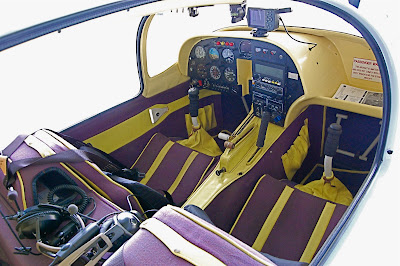Hip hip hooray! I finally got to fly! For those of you who don't know, my roommates father has been a pilot for 35 years and will be retiring from Hawaiian Airlines next year after 25 years with them. He started as a "puddle jumper" with Hawaiian, flying from one island to the next. After four years, he gained enough seniority to fly routes from the mainland to Hawaii. Currently he flies the Boeing 767-300ER out of SEATAC.
Ohhh, ahhh, can't wait to get in!
Being that flying is his passion in life, he also flies on his days off. At the Olympia airport, there are two planes tucked away inside a hangar, one belonging to his father, and the other his own. Today we flew in his plane, a small "kit plane" two-seater, for almost an hour. After cruising around for a while, he gave me the controls for about 20 minutes. It was great being in control of a plane... what an incredible feeling of exhilaration it gives! We then headed back to the airport, and just in time, as lil' ol' me wasn't feeling too great. After all the sunny weather we've been getting, today was pretty cloudy and windy, especially for a small plane. Well, it really wasn't that bad, but my stomach just can't take much. To fly VFR (visual flight rules) you need to have a minimum 1,000 foot ceiling (before the clouds) and three miles of visibility. We easily had the visibility, but the cloud ceiling was just a tad above 1,500 feet. So we flew between 800 and 1,300 feet for just over 100 miles. Not a bad first flight. Now if only I could get my air legs under me! :)

Will I fit? Actually it wasn't that bad!
These kits are pretty spendy, but extremely efficient. The engine on this plane is only 110 horsepower and weighs in at a measly 150 lbs. However, it is turbo-charged and also has the capability of producing 100% power efficiency up to 18,000 feet. I was told this is quite rare in small engines, as the higher you get, the thinner the air is, and the less efficient the engine. Most small engines will only produce 75% power at 7,000 feet, so this makes a very large difference. One of the upgrades he's done to the plane is purchasing a new in-flight full feathering propeller, allowing the pilot to adjust the pitch for different aspects of flight. The tri-blade is made of carbon fiber and cost a cool $3,000. Looks like this hobby will be a long time in coming.
Not a bad smile considering at this point I wasn't feeling to hot and just wanted to put my feet onto solid ground.

























